Uncover Beaune's vibrant flavors and culinary gems with our expert guides. Plan an unforgettable trip now!
Read more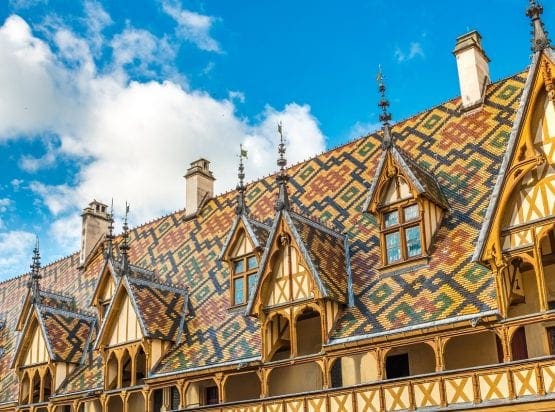
EXPLORE ALL OUR BURGUNDY WINE REGIONS GUIDE
Last updated: April 4, 2025
It’s easy to snigger at Beaujolais. In the 20th century, a phenomenon known as Beaujolais Nouveau (very young, fruity wines quaffed in the fall) went from being in vogue to tragically passé almost overnight. In the 1970s, Nouveau accounted for roughly half the region’s annual production; Beaujolais’ image suffered as consumers began to tire of this money-making gimmick.
But we should not let memories of ‘Naff Nouveau’ detract from Beaujolais’ immense strengths: unique terroir, superb red wines, and incredible value. At its best, the Gamay grape can produce structured, aromatic, and concentrated wines of real class – bottles a world away from the hackneyed trick of bubblegum-flavored plonk. Make no mistake: Beaujolais is a diverse and complex vineyard with several crus (individual terroirs) and various styles. It deserves a second chance.
Discover More About French Wine
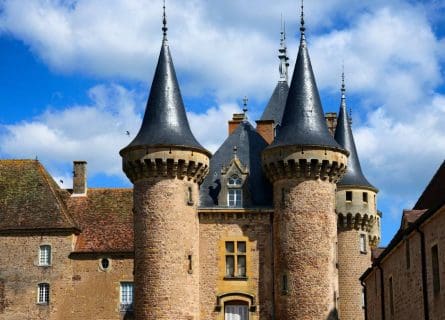
Burgundy’s golden age is universally regarded as the late Middle Ages: at its height during the 14th century, the Duchy of Burgundy was one of the wealthiest and most influential states in Europe.
Its handsome capital, Dijon, served as the headquarters of the Duchy from the 11th to 15th centuries, enjoying great prosperity under Philip the Bold, John the Fearless, and Philip the Good. During their reigns, many great works of art were produced by sculptors and painters, turning Dijon into a major center of European art.
The Ancient Roots of Beaujolais Winemaking
However, winegrowing in Beaujolais predates the Duchy of Burgundy by over a thousand years. The Romans planted vines after conquering Gaul (France) in 50 BC; wine became essential to Roman social and cultural life. The renowned Beaujolais cru, Morgon, is said to have been first planted by the Romans. Yet after the Western empire collapsed in AD 476, all turned to chaos – this was Europe’s so-called ‘Dark Ages.’
In its aftermath, two monastic orders rose to prominence in the 7th century: the Cistercians and the Benedictines. The latter assumed custody of Beaujolais’ Gamay vineyards, although the Dukes of Burgundy eventually seized this privilege. Unfortunately, the local aristocracy took a great dislike to this once unfairly maligned grape variety.
The Controversy and Migration of Gamay
Indeed, Gamay was once found in abundance further north in what we now call the Cote d’Or until the Duke of Burgundy, Philippe the Bold, outlawed the grape’s cultivation. At this time, the ruling class was more interested in increasing Pinot Noir’s production, which was seen as a much more noble variety.
So, it was unsurprising that his successor, Philipe the Good, issued a further ruling against planting the grape. The result was that growers moved further south to the region we know as Beaujolais, taking their beloved Gamay with them. Meanwhile, the Duchy expanded its territories to include Alsace, Luxembourg, and the Low Countries.
Nevertheless, this was a time of bitter rivalry between Burgundy and France – the Burgundians allied with the English and betrayed Joan of Arc to France’s mortal enemies. Yet in the late 1400s, French armies defeated the Duchy, absorbing the region into the centralized state.
From Regional Delicacy to Global Phenomenon
Today, Beaujolais’ wines are consumed globally, although, for many centuries, demand was confined to the regional markets of southern France. Its heyday occurred in the 19th century when the construction of French railways enabled the shipping of wines to Paris and beyond.
Then came the massive – but ultimately fickle – attraction of Beaujolais Nouveau in the 80s, with consumers lining up to drink very young and straightforward wines barely 2-3 months old. Thankfully, this fad soon played out worldwide, allowing growers to focus on producing distinctive wines that reaffirmed the region’s reputation for quality.
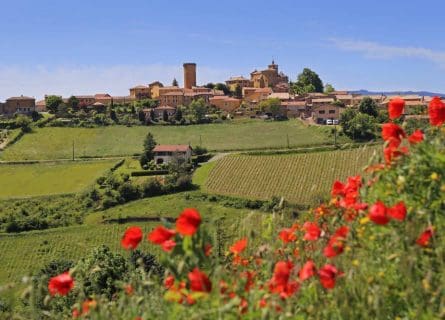
This beautiful region is located southwest of the Maconnais zone – an easy day trip from Lyon. It runs for approximately 34 miles from north to south, beginning at Macon and ending on the outskirts of Lyon. A great deal of wine is made here: over 18,000 hectares can produce nearly 1.5 billion bottles in plentiful years.
There are two key subregions in Beaujolais: Bas Beaujolais and Haut Beaujolais. The former extends south from the city of Villefranche-sur-Saône and is responsible for marketing a great deal of Beaujolais Nouveau to the world. Clay-limestone soils yield berries with moderate alcohol and supple tannins, ideal for making quaffable Gamay.
The Distinct Subregions of Beaujolais
Yet Haut Beaujolais gains renown for its granite terroir, consequently producing more structured and powerful wines. Situated north of Villefranche, Haut Beaujolais produces an altogether superior breed of Gamay: ripe, elegant, and age-worthy reds that do justice to Beaujolais’ unfairly maligned name. Growers covet vineyards planted on well-drained soils with a south-facing aspect – Beaujolais Villages refers to wines from 38 demarcated villages spread across the appellation.
The Prestigious Crus of Beaujolais
However, the top tier of Beaujolais emanates from the ten recognized crus from within the Haut Beaujolais area. A Cru refers to an entire wine-producing subregion, most commonly named after the local village. What you often won’t see, though, is winemakers choosing not to advertise the region’s name on labels, as they prefer consumers not to associate their superior wines with ‘Beaujolais ordinaire.’
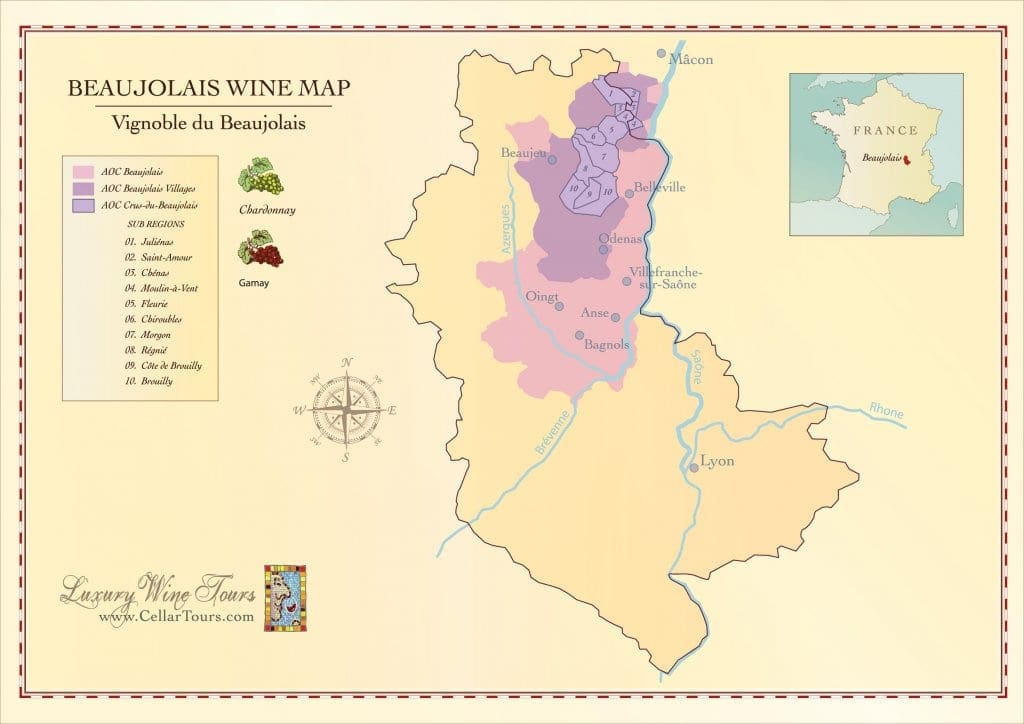
The bulk of production falls under the AOC Beaujolais appellation, which covers wines from all 96 villages in the region. With such a large geographical area, there is naturally a variance in quality, but good examples are richly fruity, low in acidity and tannins, very quaffable, and hard to resist.
Many red wines in Beaujolais undergo carbonic or semi-carbonic maceration, which is the secret behind its juicy fruit flavors and supple texture.
Understanding Carbonic Maceration
So what is carbonic maceration? It involves undertaking two fermentations simultaneously but independently, producing a wine with low tannin levels. Whole uncrushed grape bunches are added to stainless steel tanks, and the bottom third of the grapes are crushed, allowing for a gentle fermentation spurned on by the yeasts naturally found in the skins.
As a byproduct of the fermentation, carbon dioxide then starts to fill the container. Thus, CO2 provides the catalyst for a chemical reaction in the intact berries at the top. It encourages enzymes contained in the berries to ‘come alive’ and consume the sugar within the grape, turning it into alcohol. We refer to this process as intracellular fermentation; it generates the critically derided pear drop and bubblegum flavors of Beaujolais Nouveau.
Typically, the process involves pressing the liquid with unfermented berries as part of the mix. This concoction of wine and ‘must’ undergoes rapid fermentation, fining, filtering, and bottling. It can be on the market less than three months after the harvest.
Traditional Fermentation for the Finest Crus
However, winemakers will seldom treat the best Beaujolais crus in this way. A more traditional fermentation will likely occur, capped off with a period of maturation in oak. The best reds are enhanced by the structure and flavor of new oak; however, inferior wines are merely subjugated by it. In addition, a very small volume of Chardonnay is made in Beaujolais and marketed under the appellation Beaujolais Blanc. The best wines are fruity and fresh – a reliable alternative to Macon Blanc.
Discover more about Burgundy Wine Classifications
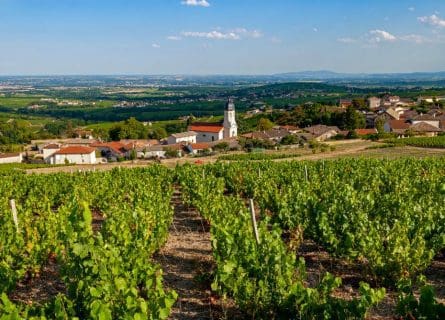
Over the past 15 years, Beaujolais has been engaged in an essential battle of image and reputation, promoting itself as an innovative, exciting wine region rather than merely the source of disposable and one-dimensional Beaujolais Nouveau. This fight and commitment to quality have paid dividends: Oenophiles increasingly seek out Beaujolais crus, marveling at the unrivaled value for money.
One of the most trendy today is Saint-Amour. The subregion borders the Maconnais zone – wines from Saint-Amour tend to be light and supremely elegant. At the same time, Julienas benefits from well-positioned slopes, clay soils, and a firmament of quality-conscious winemakers.
Discovering the Diversity of Beaujolais Crus
Meanwhile, its neighbor Chenas has some higher, steep vineyards, but the wines veer toward the lighter side. Yet, for Beaujolais of real depth, structure, and power, you need to search out Moulin-à-Vent from a leading grower. Another favorite with connoisseurs and critics is the cru of Fleurie, the best examples of which are strongly perfumed and unequaled for their lush texture and density of fruit.
Even more refined are the wines of Chiroubles, produced from the finest grapes in the most elevated vineyards in the region – the very taste and smell of elegance.
The New and Noteworthy in Beaujolais
We then arrive at the village of Morgon, renowned for its dense, powerful interpretations of the Gamay grape; the best examples should be cellared for 3-5 years to enjoy them at their best. The newest addition to the Cru family is Regnie, producing some of the most exciting wines in the region.
, the large Brouilly Cru, closer to the southern end of the area, surrounds the hill of Mont Brouilly, whose slopes provide the attractively fruity Cote de Brouilly. Expect plenty of excellent value, lightish wines that are enjoyable on release and stuffed full of red berry fruit.
Elevating ‘Everyday Beaujolais’
Yet it is a mistake to regard all non-cru Beaujolais as forgettable and ‘frivolous.’ Better winemaking and vineyard management, spearheaded by a younger firmament of growers, is having a decisive impact on ‘everyday Beaujolais.’ As a result, the fruit is less confected, and the flavors are more pronounced.
These wines are delightful, fun, and playful on a warm summer evening. Should we deride young Beaujolais just because it isn’t serious or age-worthy? Of course not; the real beauty of Beaujolais today is the incredible diversity of styles, from light and supple to rosé, white, and the impressively concentrated examples from the leading villages or crus in the region.
A Beacon of Value in the Wine World
Meanwhile, prestigious Burgundy reds – and whites – from the Côte d’Or have floated off into oligarch territory, never to return. So, our advice is to look to the Gamay grape for both quality and inspiration. In a world dominated by ludicrous prices and blue-chip collectibles, we need Beaujolais more than ever.
Chardonnay is a green-skinned grape varietal native to the Burgundy wine region in France and one of the most popular varieties worldwide.
Find out moreGamay Noir is a grape variety used to make light-bodied red wine, most notably grown in the Beaujolais region.
Find out moreOenophiles, gastronomes, and foodies – welcome to paradise. Burgundy celebrates its fabulous produce worldwide, from Bresse chicken to the exquisite soft cheeses of Epoisses. In Dijon and Beaune, local restaurants have earned renown for assisting diners in selecting the right wine for each dish; young Beaujolais, served slightly chilled, serves as an excellent aperitif. But the crus deserve a memorable culinary pairing; coq au vin or bœuf bourguignon will do nicely.
Guide to the Gastronomy of Burgundy: Read more

Uncover Beaune's vibrant flavors and culinary gems with our expert guides. Plan an unforgettable trip now!
Read more
Uncover Dijon's vibrant flavors and culinary gems with our expert guides. Plan an unforgettable trip now!
Read more
Uncover Lyon's vibrant flavors and culinary gems with our expert guides. Plan an unforgettable trip now!
Read moreIf you would like us to customize an exclusive luxury tour, contact us and let us know your travel plans. We offer luxury food and wine tours for private groups of a minimum two guests. In addition, all of our private, chauffeured tours are available year-round upon request.

